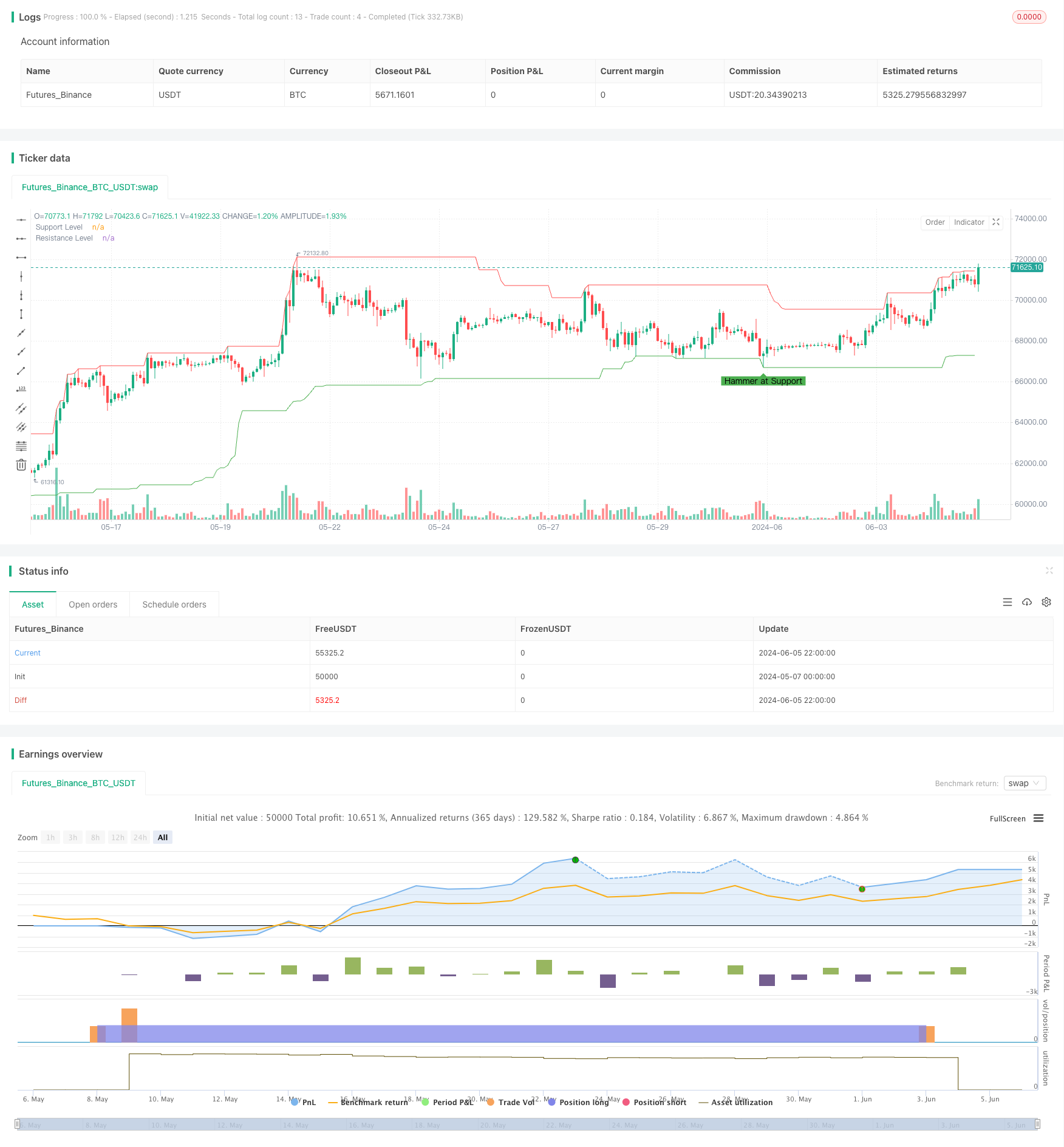
概述
该策略基于技术分析中的反转形态(锤头线、吞没形态和十字星)以及支撑位和阻力位,在1小时图表上进行交易。策略通过识别潜在的市场反转点,并在预定的止盈和止损水平执行交易。
该策略的主要思路是在支撑位附近出现看涨反转形态(如锤头线、看涨吞没形态或十字星)时开多仓,在阻力位附近出现看跌反转形态(如锤头线、看跌吞没形态或十字星)时开空仓。同时设置止盈和止损水平,以控制风险和锁定利润。
策略原理
- 通过 ta.lowest() 和 ta.highest() 函数分别计算指定回望期内的最低价和最高价,确定支撑位和阻力位。
- 判断当前蜡烛图是否形成锤头线、吞没形态或十字星。
- 如果在支撑位附近出现看涨反转形态,开多仓;如果在阻力位附近出现看跌反转形态,开空仓。
- 设置止盈价格为开仓价格的3%,止损价格为开仓价格的1%。
- 当价格达到止盈或止损水平时,平仓。
策略优势
- 结合反转形态和关键支撑阻力位,提高交易信号的可靠性。
- 设置明确的止盈和止损水平,有效控制风险。
- 适用于趋势和震荡市场,可捕捉潜在的反转机会。
- 代码简洁,易于理解和实现。
策略风险
- 在震荡市场中,频繁出现反转信号,可能导致过度交易和手续费损失。
- 支撑位和阻力位的判断依赖于回望期的选择,不同的回望期可能导致不同的结果。
- 反转形态的可靠性并非绝对,虚假信号可能导致亏损。
解决方法: 1. 通过调整反转形态的参数和确认条件,减少虚假信号。 2. 结合其他技术指标或市场情绪指标,提高信号的可靠性。 3. 适当调整止盈和止损水平,以应对不同的市场状况。
策略优化方向
- 引入交易量指标,确认反转形态的有效性。高交易量的反转形态可能更可靠。
- 考虑多个时间框架的支撑阻力位,提高支撑阻力位的准确性。
- 结合趋势指标,如移动平均线,在趋势方向上进行交易,避免逆势交易。
- 优化止盈和止损水平,根据市场波动性动态调整,以获得更好的风险回报比。
总结
该策略通过识别支撑位和阻力位附近的反转形态,捕捉潜在的交易机会。它简单易用,适用于不同的市场环境。然而,策略的成功依赖于对反转形态和支撑阻力位的准确判断。通过优化交易信号的确认条件,结合其他技术指标,以及动态调整止盈止损水平,可以进一步提高策略的表现。
策略源码
/*backtest
start: 2024-05-07 00:00:00
end: 2024-06-06 00:00:00
period: 2h
basePeriod: 15m
exchanges: [{"eid":"Futures_Binance","currency":"BTC_USDT"}]
*/
// This Pine Script™ code is subject to the terms of the Mozilla Public License 2.0 at https://mozilla.org/MPL/2.0/
// © Kingcoinmilioner
//@version=5
strategy("Reversal Patterns at Support and Resistance", overlay=true, default_qty_type=strategy.percent_of_equity, default_qty_value=100)
// Parameters
support_resistance_lookback = input.int(50, title="Support/Resistance Lookback Period")
reversal_tolerance = input.float(0.01, title="Reversal Tolerance (percent)", step=0.01) / 100
take_profit_percent = input.float(3, title="Take Profit (%)") / 100
stop_loss_percent = input.float(1, title="Stop Loss (%)") / 100
// Functions to identify key support and resistance levels
findSupport() =>
ta.lowest(low, support_resistance_lookback)
findResistance() =>
ta.highest(high, support_resistance_lookback)
// Identify reversal patterns
isHammer() =>
body = math.abs(close - open)
lowerWick = open > close ? (low < close ? close - low : open - low) : (low < open ? open - low : close - low)
upperWick = high - math.max(open, close)
lowerWick > body * 2 and upperWick < body
isEngulfing() =>
(close[1] < open[1] and close > open and close > open[1] and open < close[1])
(close[1] > open[1] and close < open and close < open[1] and open > close[1])
isDoji() =>
math.abs(open - close) <= (high - low) * 0.1
// Identify support and resistance levels
support = findSupport()
resistance = findResistance()
// Check for reversal patterns at support and resistance
hammerAtSupport = isHammer() and (low <= support * (1 + reversal_tolerance))
engulfingAtSupport = isEngulfing() and (low <= support * (1 + reversal_tolerance))
dojiAtSupport = isDoji() and (low <= support * (1 + reversal_tolerance))
hammerAtResistance = isHammer() and (high >= resistance * (1 - reversal_tolerance))
engulfingAtResistance = isEngulfing() and (high >= resistance * (1 - reversal_tolerance))
dojiAtResistance = isDoji() and (high >= resistance * (1 - reversal_tolerance))
// Trading logic
if (hammerAtSupport or engulfingAtSupport or dojiAtSupport)
strategy.entry("Long", strategy.long)
stop_level = low * (1 - stop_loss_percent)
take_profit_level = close * (1 + take_profit_percent)
strategy.exit("Take Profit/Stop Loss", from_entry="Long", stop=stop_level, limit=take_profit_level)
if (hammerAtResistance or engulfingAtResistance or dojiAtResistance)
strategy.entry("Short", strategy.short)
stop_level = high * (1 + stop_loss_percent)
take_profit_level = close * (1 - take_profit_percent)
strategy.exit("Take Profit/Stop Loss", from_entry="Short", stop=stop_level, limit=take_profit_level)
// Plot support and resistance levels for visualization
plot(support, color=color.green, linewidth=1, title="Support Level")
plot(resistance, color=color.red, linewidth=1, title="Resistance Level")
// Plot reversal patterns on the chart for visualization
plotshape(series=hammerAtSupport, location=location.belowbar, color=color.green, style=shape.labelup, text="Hammer at Support")
plotshape(series=engulfingAtSupport, location=location.belowbar, color=color.green, style=shape.labelup, text="Engulfing at Support")
plotshape(series=dojiAtSupport, location=location.belowbar, color=color.green, style=shape.labelup, text="Doji at Support")
plotshape(series=hammerAtResistance, location=location.abovebar, color=color.red, style=shape.labeldown, text="Hammer at Resistance")
plotshape(series=engulfingAtResistance, location=location.abovebar, color=color.red, style=shape.labeldown, text="Engulfing at Resistance")
plotshape(series=dojiAtResistance, location=location.abovebar, color=color.red, style=shape.labeldown, text="Doji at Resistance")